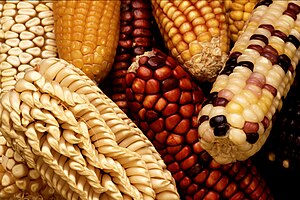People sometimes equate the idea of organic gardening with heirloom gardening, but the two are not quite the same, even if they overlap to a great extent. "Heirloom" essentially refers to original types of plants, many of which are no longer produced commercially or on a large scale but which are kept in existence by those who hand down the seeds, generation after generation. Many heirloom fruits, vegetables, and flowering plants are virtually the same as they were hundreds of years ago.
|
|
| Genetic diversity in corn. (Photo credit: Wikipedia) |
Most modern, commercially produced fruits and vegetables are hybrids, that is, plants that have had their genetics altered by cross-breeding or outright genetic modification. They have been bred to be produced in large volumes and to be disease- or drought-resistant, and for the fruits to last a long time as they are transported over vast distances. As a result, taste itself has often been sacrificed for the sake of mass production, longevity, and profit. And frequently these alterations mean that there might only be a very few different kinds of particular fruits or vegetables on the market, rather than the hundreds of varieties of the same plant that used to exist.
(For a shocking glimpse at just how many varieties we've already lost, check out this eye-opening graphic: http://nhlsustainablegardening.blogspot.com/2012/02/seed-diversity-shocking-image.html )
Most people don't realize that this situation, this "monoculture" as it's called, can put those few varieties in actual danger. One monolithic variety could be susceptible to a specific deadly virus, and that entire kind of food could actually become extinct if the disease strikes. On the other hand, having many different varieties increases the chance of the survival of the food, as one breed might fall to a virus while others are resistant.
|
|
| Heirloom tomatoes are a popular choice for gardeners. (Photo credit: Wikipedia) |
For these reasons and many others, groups and individuals have arisen that seek to preserve and increase the food and other plant varieties that have fallen out of commercial favor. The seeds they save from the growing of these older varieties start out as organic, by definition, because they have not been altered by non-natural means, nor have they been chemically treated. But their planting, fertilization, and harvesting could still end up not falling into the "organic" category if pesticides or herbicides are used, or if non-organic methods are used in the actual gardening.
So you can see that while heirloom gardening has many of the same goals as organic gardening, they aren't always identical.
The true organic gardener who wishes to produce heirloom varieties will use these preserved seeds, and then will utilize the methods associated with organic gardening on top of that. He or she will avoid the synthetic fertilizers, pesticides, and herbicides, will use natural methods of dealing with insects and other pests, and will employ natural composts and fertilizing systems to keep the soil healthy and full of nutrients. Even the pollination of the flowers that produce the fruits or vegetables will be accomplished by "open pollination," that is, via bees, insects, or the wind. This will result in vigorous seeds that breed true in the following generation, unlike many of the hybrids that don't always produce the same results in the second or third generation of the plant.
An organic gardener may plant hybrid varieties, yet use organic methods in the actual gardening. And conversely, an heirloom gardener could begin with organic heirloom seeds, but use non-organic methods. It's only when the two are combined that one will be a true organic heirloom gardener.
For a great source for organic heirloom seeds, visit www.nonhybridseeds.com.



No comments:
Post a Comment